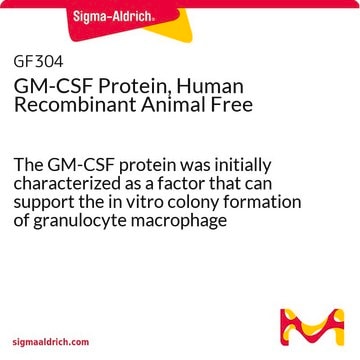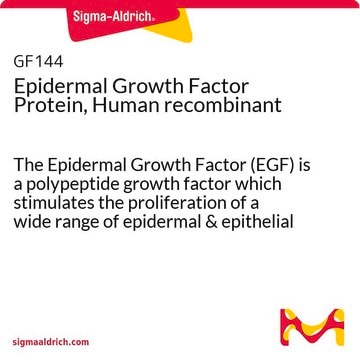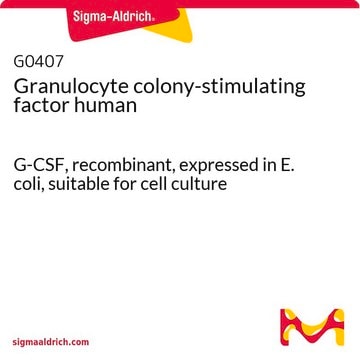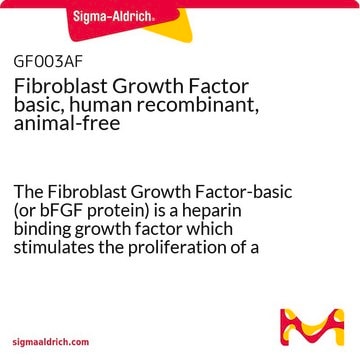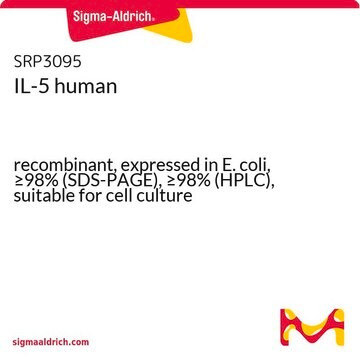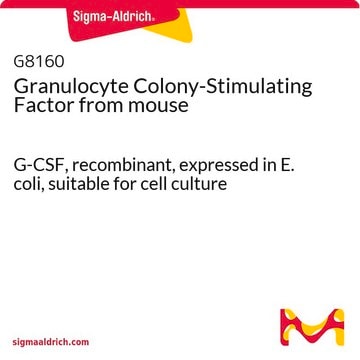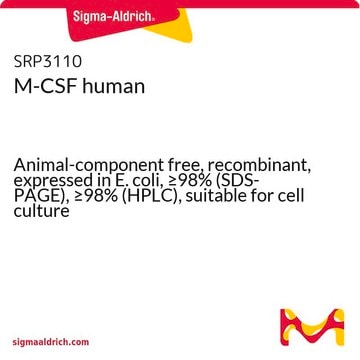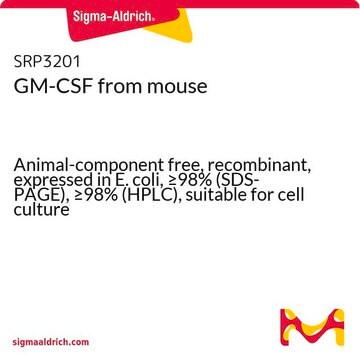추천 제품
생물학적 소스
human
Quality Level
재조합
expressed in HEK 293 cells
분석
≥95% (SDS-PAGE)
형태
lyophilized powder
효능
≤5 ng/mL EC50
품질
endotoxin tested
분자량
dimer 15-36 kDa (glycosylated)
포장
pkg of 5X10 μg
pkg of 10 μg
저장 조건
avoid repeated freeze/thaw cycles
기술
cell culture | mammalian: suitable
불순물
≤1 EU/mg
UniProt 수납 번호
저장 온도
−20°C
유전자 정보
human ... CSF2(1437)
유사한 제품을 찾으십니까? 방문 제품 비교 안내
일반 설명
Granulocyte-Macrophage Colony-Stimulating Factor is mapped to human chromosome 5q21-q32.
애플리케이션
Granulocyte-Macrophage Colony-Stimulating Factor human has been used as a colony-stimulating cytokine in human acute myeloid leukemia cell line (OCI-M2) to test its effect on 5-azacitidin (AZA)-mediated DNA demethylation of upstream regulatory element (URE).
생화학적/생리학적 작용
Granulocyte-Macrophage Colony-Stimulating Factor (GM-CSF) is an immune modulator and proinflammatory cytokine. It binds to the heteromeric cell-surface receptors present in the immune cells like granulocytes, endothelial cells and macrophages. GM-CSF is implicated in inflammation associated disorder of the lung and renal system.
Granulocyte-macrophage colony stimulating factor (GM-CSF) is a growth and differentiation factor for cells in the granulocyte, macrophage and eosinophil lineage. GM-CSF stimulates colony formation from pluripotential progenitor cells at extremely low concentrations and is an essential survival and proliferative factor for hematopoietic progenitor cells in all divisions up to maturity. It also stimulates growth in some epithelial cells and osteoclasts. GM-CSF is produced by a variety of cell types (monocytes, endothelial cells, T-cells, fibroblasts, mitogen-stimulated B-cells, and LPS-stimulated macrophages). GM-CSF is secreted as a single chain glycoprotein containing 128 amino acids for human with a conserved disulfide bond. Human and murine GM-CSF share approx. 54% sequence homology and do not cross-react in bioactivity.
주의사항
Although human and mouse GM-CSF share 54% amino acid sequence homology, their biological actions are species-specific and exhibit no cross-species reactivity.
물리적 형태
Lyophilized from a 0.2 μm filtered solution of 1x PBS.
제조 메모
HumanKine GM-CSF is expressed as a 15-36 kDa glycosylated monomer in human HEK 293 cells. Production in human HEK 293 cells offers authentic glycosylation. Glycosylation contributes to stability in cell growth media and other applications. Although human and mouse GM-CSF share 54% amino acid sequence homology, their biological actions are species-specific and exhibit no cross-species reactivity.
분석 메모
The specific activity was determined by the dose-dependent stimulation of the proliferation of human TF-1 cells (human erythroleukemic indicator cell line).
법적 정보
HumanKine is a registered trademark of Proteintech Group, Inc. and Humanzyme, Inc
Storage Class Code
11 - Combustible Solids
WGK
WGK 3
Flash Point (°F)
Not applicable
Flash Point (°C)
Not applicable
시험 성적서(COA)
제품의 로트/배치 번호를 입력하여 시험 성적서(COA)을 검색하십시오. 로트 및 배치 번호는 제품 라벨에 있는 ‘로트’ 또는 ‘배치’라는 용어 뒤에서 찾을 수 있습니다.
이미 열람한 고객
K Huebner et al.
Science (New York, N.Y.), 230(4731), 1282-1285 (1985-12-13)
Human granulocyte-macrophage colony-stimulating factor (GM-CSF) is a 22,000-dalton glycoprotein that stimulates the growth of myeloid progenitor cells and acts directly on mature neutrophils. A full-length complementary DNA clone encoding human GM-CSF was used as a probe to screen a human
Yufang Shi et al.
Cell research, 16(2), 126-133 (2006-02-14)
Granulocyte-macrophage colony-stimulating factor (GM-CSF) is an important hematopoietic growth factor and immune modulator. GM-CSF also has profound effects on the functional activities of various circulating leukocytes. It is produced by a variety of cell types including T cells, macrophages, endothelial
Julie M Vose et al.
Leukemia & lymphoma, 50(9), 1412-1421 (2009-07-16)
In autologous stem cell transplantation, mobilized peripheral blood has replaced the bone marrow as the preferred source of hematopoietic stem cells (HSCs). Because HSCs normally exist in the blood in very low numbers, the use of agents to "mobilize" HSCs
Stephanie S Watowich et al.
Immunological reviews, 238(1), 76-92 (2010-10-26)
Understanding the diversification of dendritic cell (DC) lineages is one of the last frontiers in mapping the developmental hierarchy of the hematopoietic system. DCs are a vital link between the innate and adaptive immune responses; thus, elucidating their developmental pathways
N Curik et al.
Leukemia, 26(8), 1804-1811 (2012-02-22)
Epigenetic 5-azacitidine (AZA) therapy of high-risk myelodysplastic syndromes (MDS) and acute myelogenous leukemia (AML) represents a promising, albeit not fully understood, approach. Hematopoietic transcription factor PU.1 is dynamically regulated by upstream regulatory element (URE), whose deletion causes downregulation of PU.1
문서
Read article on hematopoietic cytokines and hematopoiesis
자사의 과학자팀은 생명 과학, 재료 과학, 화학 합성, 크로마토그래피, 분석 및 기타 많은 영역을 포함한 모든 과학 분야에 경험이 있습니다..
고객지원팀으로 연락바랍니다.

